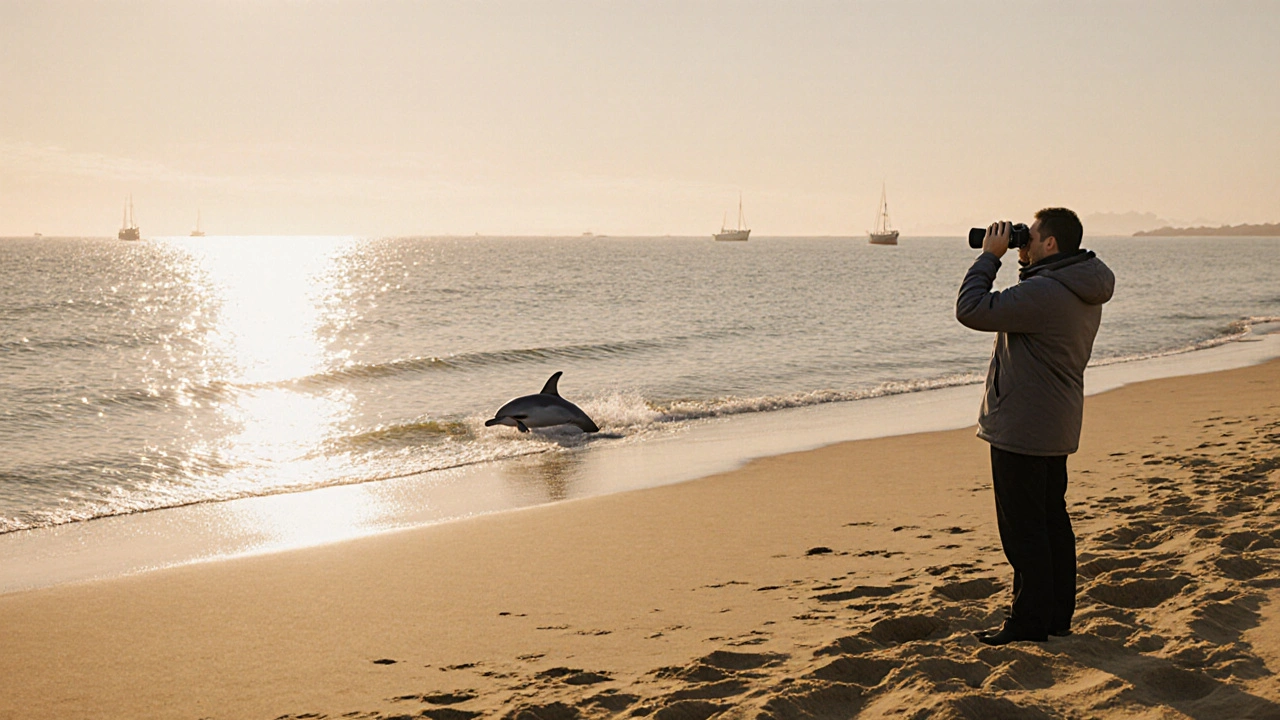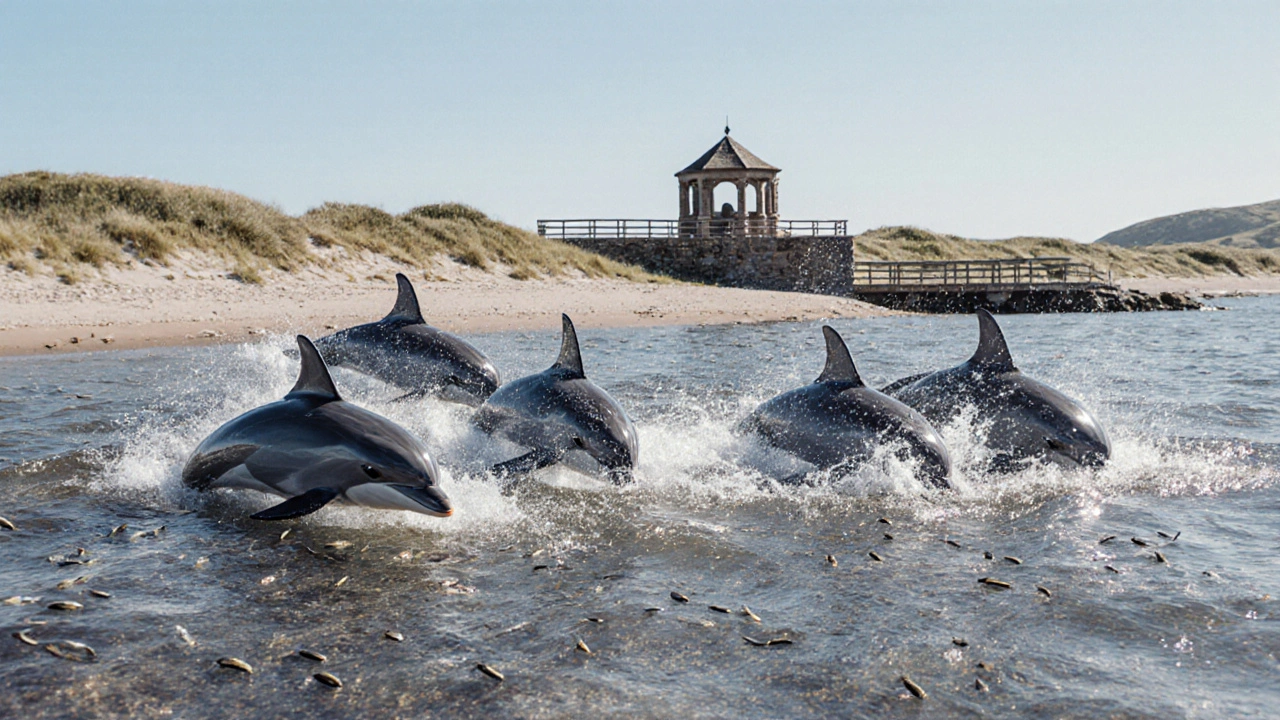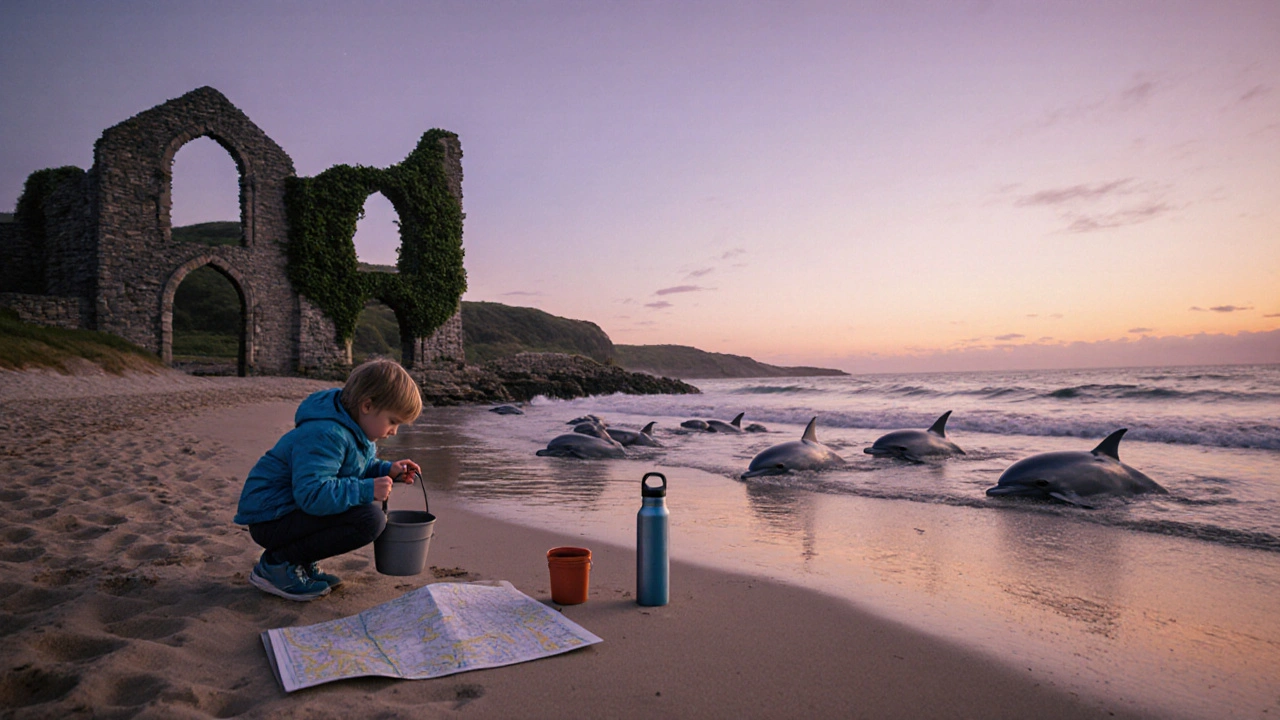
Most people think of Tain Beach as just another stretch of sand along Scotland’s northeast coast. But if you’ve ever stood there at low tide, watching the waves roll in and spotting a sleek gray back break the surface just offshore, you know it’s something else entirely. Tain Beach isn’t just a place to walk your dog or build a sandcastle. It’s one of the most reliable spots on the entire East Coast to see wild bottlenose dolphins in their natural habitat.
What Makes Tain Beach Different?
Tain Beach sits where the River Dornoch meets the Moray Firth, about 15 miles north of Inverness. The beach itself is wide, flat, and mostly untouched by crowds. Unlike the busy resorts down south, you won’t find ice cream vans or lifeguard towers here. Just salt air, shifting dunes, and the occasional fishing boat bobbing in the distance.
The real magic? The water just offshore is a feeding ground for bottlenose dolphins. These aren’t captive animals in a show. These are wild, intelligent creatures that return here year after year. Scientists from the Moray Firth Dolphin Project have been tracking them since the 1990s. Over 200 individual dolphins have been identified in this stretch of water. Some of them - like a female named Spout - have been seen for more than 25 years.
What draws them here? The fish. The Moray Firth is rich in herring, sprat, and sand eels. Dolphins hunt in groups, using coordinated clicks and body movements to herd schools into tight balls. You’ll often see them diving in unison, tails flashing silver as they surface for air. Sometimes they leap. Sometimes they spin. And sometimes, if you’re quiet and patient, they’ll swim close enough to the shore to make eye contact.
When to Go for Dolphin Sightings
Timing matters. Dolphins aren’t guaranteed to show up every day, but your odds are best between April and October. Summer months - June through August - are peak season. Water temperatures rise, fish move closer to shore, and dolphin activity spikes.
For the best chance of seeing them, arrive at least an hour before high tide. The water is calmer, and dolphins tend to move closer to the beach during incoming tides. Low tide exposes mudflats and rock pools, but dolphins usually stay farther out. Sunrise and sunset are golden hours - not just for photos, but for sightings. The light is soft, the sea is still, and dolphins are most active.
Winter visits aren’t useless. You’ll see fewer dolphins, but you’ll also have the beach almost to yourself. And if you’re lucky, you might spot a harbor seal lounging on a sandbar or a flock of oystercatchers skittering along the water’s edge.
How to Watch Dolphins Without Disturbing Them
Watching dolphins at Tain Beach doesn’t require a boat. You don’t even need binoculars - though they help. The key is staying still and quiet.
- Stay on the beach. Don’t wade into the water. Dolphins avoid people in the water, even if they seem curious.
- Keep your voice down. Loud noises, especially from phones or radios, can scare them away.
- Don’t chase them. If you see dolphins moving offshore, don’t run along the shore trying to keep up. Let them come to you.
- Use the Tain Beach Dolphin Watch app. It’s free, run by local conservationists, and sends alerts when dolphins are spotted nearby.
- Bring a warm jacket. Even in summer, the wind off the firth can drop the temperature fast.
Never feed them. Never throw anything into the water. And if you see a group of tourists shouting or trying to swim with the dolphins, walk away. You’re here to observe, not interfere.

What Else You’ll Find at Tain Beach
While dolphins are the star attraction, Tain Beach offers more than just marine life. The sand is fine and golden, perfect for barefoot walks. At the northern end, you’ll find a small tidal pool system that fills with water during high tide - great for kids to explore with a bucket and net.
There’s a wooden boardwalk that leads from the parking area to the beach, making it accessible for strollers and wheelchairs. A small stone pavilion near the entrance has benches and a map showing dolphin sighting hotspots. It’s not fancy, but it’s useful.
Just inland, the village of Tain offers a few cozy cafés. Try the smoked salmon sandwich at The Old Post Office - it’s made with fish caught just a mile offshore. The local brewery, Tain Ales, makes a sea salt and kelp ale that tastes like the coast itself.
For history buffs, the ruins of Tain Royal Burgh’s 12th-century priory sit a 10-minute walk from the beach. It’s quiet, overgrown with ivy, and feels like stepping back 800 years.
How to Get There and Where to Park
Tain Beach is easy to reach by car. From Inverness, take the A9 north for about 18 miles, then turn right onto the B9169 toward Tain. Follow signs for the beach - there’s a small brown sign near the roundabout.
Parking is free but limited. There’s a gravel lot with space for about 30 cars. Arrive before 10 a.m. on weekends to guarantee a spot. If it’s full, you can park along the side road near the Tain Golf Club - a 5-minute walk to the beach.
Public transport options are limited. The Stagecoach 28 bus runs from Inverness to Tain twice an hour during the day, but you’ll still need to walk 1.2 miles from the town center. Bring comfortable shoes.

What to Bring
- Waterproof jacket (even if it’s sunny - the wind changes fast)
- Binoculars or a camera with a zoom lens
- Thermos with hot tea or coffee
- Snacks - no shops on the beach
- Sturdy shoes for walking on sand and rocks
- Reusable water bottle
- Dolphin identification guide (download the free PDF from the Moray Firth Dolphin Project website)
Leave nothing behind. The beach is protected under the European Marine Site designation. Plastic bags, bottles, or even biodegradable food wrappers can harm marine life.
Why This Matters
Tain Beach isn’t just a tourist spot. It’s part of a larger effort to protect one of Europe’s last healthy populations of bottlenose dolphins. In the 1980s, these dolphins were nearly wiped out by fishing nets and pollution. Today, thanks to strict no-fishing zones and community-led monitoring, their numbers are growing.
Every visitor who watches quietly, leaves no trace, and shares what they’ve seen helps keep this place alive. You’re not just seeing dolphins. You’re supporting a conservation success story.
Some people come to Tain Beach for the peace. Others come for the photos. But those who return year after year? They come because they’ve seen a dolphin leap just yards from shore - and realized, for the first time, how alive the sea really is.
Can you see bottlenose dolphins at Tain Beach all year round?
Yes, but sightings are most common between April and October. Winter months have fewer dolphins, and the weather is harsher. The best months for reliable sightings are June through August, when water temperatures are warmest and fish are abundant near shore.
Do you need a boat to see dolphins at Tain Beach?
No. Tain Beach is one of the few places in Scotland where you can see wild bottlenose dolphins from land. The water is shallow and clear enough close to shore that you can spot them without a boat. Many visitors see them just by standing still on the beach with binoculars.
Is Tain Beach safe for children?
Yes. The beach is flat, with gentle slopes and no strong currents near the shore. The tidal pools at the northern end are perfect for kids to explore. Just keep an eye on them near the water’s edge, especially during high tide, and always stay on marked paths.
Are there any facilities at Tain Beach?
There are no restrooms or shops directly on the beach. The nearest public toilets are in the village of Tain, about a 10-minute walk away. There’s a small pavilion with benches and a dolphin sighting map near the parking area. Bring everything you need with you.
Can you swim with dolphins at Tain Beach?
No. Swimming with wild dolphins is illegal in Scotland and dangerous for both people and animals. Dolphins are protected under UK and EU law. Getting in the water to chase or approach them can stress the animals and lead to fines. Always watch from the shore.
What should you do if you see an injured dolphin?
Do not touch it. Keep your distance and call the Scottish Marine Animal Stranding Scheme at 0800 652 0333. They’re on call 24/7 and will send trained responders. Take a photo from afar if you can - it helps them identify the animal. Never try to push it back into the water.
Comments (9)
-
Rubina Jadhav November 12, 2025
This place sounds peaceful.
-
Jitendra Singh November 13, 2025
I visited Tain last summer. Saw Spout twice. One time she came so close I could see the scar on her dorsal fin. No boat needed. Just silence and patience. That’s all it takes.
Best hour? Sunrise. The light on the water makes everything feel sacred.
-
Shivani Vaidya November 13, 2025
The conservation ethic displayed here is exemplary. The absence of commercialization, the quiet reverence of observers, the community-driven monitoring-these are not mere amenities but moral imperatives in an era of ecological erosion.
It is rare to encounter a public space where human presence is not an intrusion but a stewardship. Tain Beach exemplifies how tourism, when tempered with humility, can become a vessel for preservation rather than exploitation.
The fact that locals have maintained this balance for decades speaks to a deeper cultural resilience. We must ask ourselves: why do so many places degrade under visitation, while this one endures?
It is not because of infrastructure or signage. It is because of collective intention. That is the true legacy of Tain.
-
sumraa hussain November 15, 2025
Man I went there last July and I swear one dolphin looked me right in the eye like we were old friends or something
It was like the sea was whispering hey you’re not just a tourist you’re part of this now
And then I spilled my coffee and the moment was ruined
But still. Life changing.
Bring a thermos. Seriously. The wind bites.
Also the kelp ale? Best thing I’ve ever tasted. Like the ocean hugged my tongue and said welcome home.
-
Raji viji November 15, 2025
Everyone’s acting like this is some mystical miracle but let’s be real-dolphins are just smart rats that learned to swim. They’re opportunistic predators, not spiritual guides.
And don’t get me started on the ‘quiet observation’ cult. You think they’re not annoyed by humans standing there like statues? They’re used to it. They’ve seen a thousand tourists with phones and binoculars.
The ‘dolphin watch app’? Cute. It’s just a glorified crowd-sourced spam feed.
And the beer? Tastes like saltwater and desperation. I’ve had better from a gas station in Aberdeen.
Don’t romanticize nature. It doesn’t care about your Instagram post.
-
Rajashree Iyer November 16, 2025
When the dolphin surfaces, it isn’t just breathing air-it’s exhaling the weight of a world that forgot how to listen.
We think we go to Tain Beach to see them.
But maybe, just maybe, they come to remind us that we still have the capacity to be still.
The sea doesn’t scream. It sighs.
And if you’re quiet enough, if you’re brave enough to let silence live inside you for a moment-you’ll hear it.
That’s not tourism.
That’s resurrection.
-
Parth Haz November 17, 2025
I appreciate the thoughtful structure of this post and the emphasis on responsible observation. The inclusion of practical advice-like arriving before high tide and avoiding water entry-is both informative and ethically grounded.
As someone who has traveled extensively along coastal regions, I’ve seen too many natural sites degraded by well-intentioned but uninformed visitors. Tain Beach serves as a model for sustainable ecotourism.
I encourage others to support the Moray Firth Dolphin Project through donations or volunteer work. Small actions, when multiplied, create lasting change.
-
Vishal Bharadwaj November 18, 2025
Wait a sec-200 dolphins? That’s impossible. The Moray Firth is too small for that many. The real number’s probably 40-50, max. The project’s inflating stats to get more funding.
And ‘Spout’? Yeah right. They name them to make people feel emotional. Like some kind of dolphin Disney movie.
Also, the ‘no fishing zones’? That’s just a cover for letting commercial trawlers move elsewhere. The real threat is industrial runoff from Aberdeen.
And why is there a boardwalk? That’s overkill. Natural beaches don’t need paved paths. This is greenwashing.
Also, typo in ‘Tain Ales’-it’s spelled ‘Tain Ales’? That’s not even a real word. Should be ‘Tain Ales’-wait no, I think it’s ‘Tain Ales’... whatever.
Also, the salmon sandwich? Probably farmed. Don’t be fooled.
-
anoushka singh November 19, 2025
Okay but why is there no cafe on the beach?? I’m dying for a latte and a croissant and you’re telling me I have to walk 10 mins??
Also I brought my dog and he barked at a seal and now I feel guilty. Should I apologize to the dolphins? Like, should I send them a note?
Also the app didn’t work on my phone. Do they have a WhatsApp group??
Also I saw a seagull steal someone’s sandwich. Is that normal? Or is that bad for the ecosystem??
Also can I take a dolphin selfie if I stand real still??
